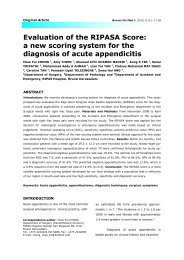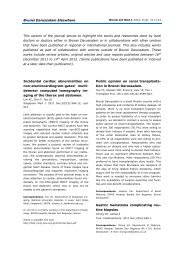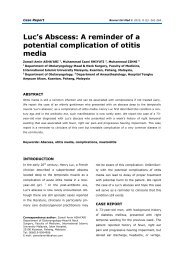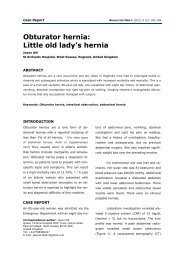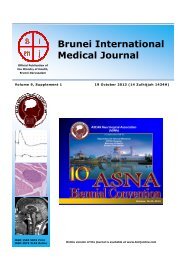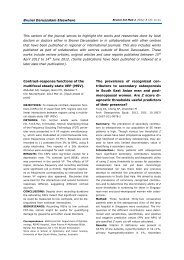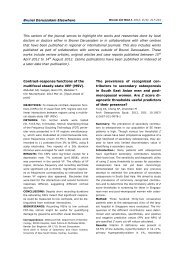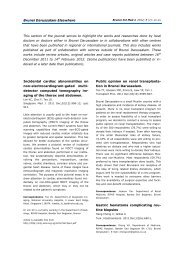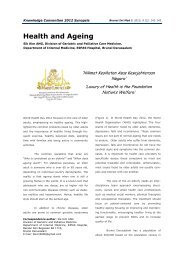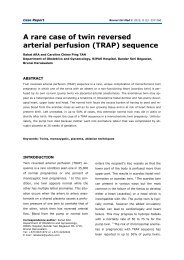Prevalence of musculoskeletal disorders in the dental profession in ...
Prevalence of musculoskeletal disorders in the dental profession in ...
Prevalence of musculoskeletal disorders in the dental profession in ...
You also want an ePaper? Increase the reach of your titles
YUMPU automatically turns print PDFs into web optimized ePapers that Google loves.
Orig<strong>in</strong>al Article<br />
Brunei Int Med J. 2013; 9 (3): 156-164<br />
<strong>Prevalence</strong> <strong>of</strong> <strong>musculoskeletal</strong><br />
<strong>disorders</strong> <strong>in</strong> <strong>the</strong> <strong>dental</strong> pr<strong>of</strong>ession<br />
<strong>in</strong> Brunei Darussalam<br />
Alice LAI 1 , Kyi Oo YIN 1 , Shivanthi BALALLA 2 , Lay Wai KHIN 3 , Nayake BP BALALLA 1 ,<br />
L<strong>in</strong> NAING 4<br />
1 Occupational Health Division, M<strong>in</strong>istry <strong>of</strong> Health, Brunei Darussalam, 2 University<br />
<strong>of</strong> Auckland, New Zealand, 3 Dean’s Office, Investigational Medic<strong>in</strong>e Unit, National<br />
University Hospital S<strong>in</strong>gapore, S<strong>in</strong>gapore, 4 PAPRSB Institute <strong>of</strong> Health Sciences,<br />
Universiti Brunei Darussalam<br />
ABSTRACT<br />
Introduction: Many health pr<strong>of</strong>essionals, <strong>in</strong>clud<strong>in</strong>g those <strong>in</strong> <strong>the</strong> <strong>dental</strong> pr<strong>of</strong>ession, suffer from workrelated<br />
<strong>musculoskeletal</strong> <strong>disorders</strong> (WMSD). Literature reviews have reported on <strong>the</strong> high prevalence as<br />
well as <strong>the</strong> significant burden <strong>in</strong> this specific pr<strong>of</strong>ession. However, we could not f<strong>in</strong>d data on <strong>the</strong> prevalence<br />
<strong>of</strong> <strong>the</strong> problem and its work-related health risk pr<strong>of</strong>iles <strong>in</strong> Brunei Darussalam. This cross-sectional<br />
study aims to determ<strong>in</strong>e <strong>the</strong> prevalence <strong>of</strong> <strong>musculoskeletal</strong> <strong>disorders</strong> (MSD) <strong>in</strong> <strong>the</strong> <strong>dental</strong> pr<strong>of</strong>ession <strong>of</strong><br />
<strong>the</strong> public sector, and identify <strong>the</strong>ir associated MSD risk pr<strong>of</strong>iles. Materials and Methods: A survey<br />
was carried out us<strong>in</strong>g a validated structured self-adm<strong>in</strong>istered questionnaire among 155 <strong>dental</strong> personnel<br />
(57% response rate) employed by <strong>the</strong> M<strong>in</strong>istry <strong>of</strong> Health <strong>in</strong> Brunei Darussalam. Questions <strong>in</strong>cluded<br />
data on demographics, general ergonomic risk, and self-reported <strong>musculoskeletal</strong> compla<strong>in</strong>ts. Results:<br />
The <strong>dental</strong> workforce was predom<strong>in</strong>antly female (69.7%), with mean age <strong>of</strong> 39 (SD 9.87) years and<br />
mean employment duration <strong>of</strong> 13.9 (SD 8.71) years. The most commonly reported body regions for<br />
<strong>musculoskeletal</strong> problems experienced <strong>in</strong> <strong>the</strong> past year were shoulders (61.7%), lower back (59.3%),<br />
upper back (55.7%), wrists/hands (53.4%), and neck (53.3%). Significant work-related associated<br />
factors for MSD were glare for neck (p
LAI et al. Brunei Int Med J. 2013; 9 (3): 157<br />
one <strong>of</strong> <strong>the</strong> most common occupational health<br />
issues caus<strong>in</strong>g <strong>in</strong>juries and illnesses that result<br />
<strong>in</strong> days away from work, job restrictions or job<br />
transfers among healthcare workers. This is<br />
most notable <strong>in</strong> <strong>the</strong> <strong>dental</strong> and nurs<strong>in</strong>g pr<strong>of</strong>essions.<br />
1 It is also a common cause <strong>of</strong> workrelated<br />
disability among workers result<strong>in</strong>g <strong>in</strong><br />
substantial f<strong>in</strong>ancial consequences due to<br />
medical expenses and worker’s compensation,<br />
as well as a burden to <strong>the</strong> employer from loss<br />
<strong>of</strong> staff productivity due to absenteeism and<br />
presenteeism. 2<br />
Studies have reported that <strong>the</strong> prevalence<br />
<strong>of</strong> WMSD <strong>in</strong> nurses over a 12-month<br />
period is as high as 85.5%. 3 A similar result<br />
is obta<strong>in</strong>ed from a systematic review <strong>of</strong> studies<br />
<strong>in</strong> dentists, <strong>dental</strong> hygienists and <strong>dental</strong><br />
students which puts <strong>the</strong> prevalence <strong>in</strong> this<br />
pr<strong>of</strong>ession between 64% and 93%. 4 As <strong>dental</strong><br />
work demands high precision with <strong>in</strong>tense<br />
hand-eye coord<strong>in</strong>ation that requires repetitive<br />
motion and excessive force <strong>of</strong>ten performed <strong>in</strong><br />
awkward and static postures, it is not surpris<strong>in</strong>g<br />
to discover this. Back pa<strong>in</strong> has <strong>of</strong>ten been<br />
cited as <strong>the</strong> most problematic chronic condition<br />
among dentists, <strong>dental</strong> hygienists and<br />
<strong>dental</strong> assistants. 5, 6 In ano<strong>the</strong>r study, upper<br />
back pa<strong>in</strong> prevalence among dentists was reported<br />
to be 72%. 7 While <strong>the</strong> occasional<br />
backache or neck pa<strong>in</strong> is not a cause for<br />
alarm, frequent pa<strong>in</strong> from cumulative physiological<br />
damage can lead to chronic <strong>in</strong>jury or a<br />
career-end<strong>in</strong>g disability. 8<br />
This alarm<strong>in</strong>gly high prevalence has<br />
resulted <strong>in</strong> grow<strong>in</strong>g concerns among health<br />
care workers on related ergonomics issues<br />
and risk factors associated with WMSD. As<br />
<strong>the</strong>re are no data on this health-related problem<br />
<strong>in</strong> Brunei Darussalam, we aimed to estimate<br />
<strong>the</strong> prevalence <strong>of</strong> <strong>musculoskeletal</strong> disorder<br />
(MSD) symptoms <strong>in</strong> <strong>the</strong> <strong>dental</strong> pr<strong>of</strong>essionals<br />
<strong>in</strong> Brunei Darussalam, and to compare<br />
prevalence between <strong>the</strong> different groups <strong>of</strong><br />
<strong>dental</strong> pr<strong>of</strong>essionals, i.e. dentists, <strong>dental</strong> nurses,<br />
<strong>the</strong>rapists and assistants, <strong>dental</strong> technicians<br />
and technologists. In addition, it was<br />
aimed to identify work-related associated factors<br />
<strong>of</strong> MSD for each body region.<br />
MATERIALS AND METHODS<br />
Study design and Study Population: A<br />
cross-sectional study was conducted target<strong>in</strong>g<br />
<strong>dental</strong> personnel work<strong>in</strong>g <strong>in</strong> <strong>the</strong> public sector<br />
<strong>in</strong> Brunei Darussalam between January and<br />
March 2011. In <strong>the</strong> registry <strong>of</strong> governmentemployed<br />
health care workers with <strong>the</strong> M<strong>in</strong>istry<br />
<strong>of</strong> Health, Brunei Darussalam <strong>in</strong> 2011,<br />
<strong>the</strong>re were 272 <strong>dental</strong> personnel <strong>in</strong>clud<strong>in</strong>g<br />
dentists (from specialist level to <strong>dental</strong> <strong>of</strong>ficers),<br />
<strong>dental</strong> <strong>the</strong>rapists/ nurses, <strong>dental</strong> assistants,<br />
<strong>dental</strong> technologists, and <strong>dental</strong> technicians,<br />
who work at ei<strong>the</strong>r specialist <strong>dental</strong><br />
cl<strong>in</strong>ics or general <strong>dental</strong> cl<strong>in</strong>ics. These cl<strong>in</strong>ics<br />
are located <strong>in</strong> <strong>the</strong> four districts <strong>of</strong> Brunei Darussalam,<br />
and serve <strong>the</strong> general population’s<br />
<strong>dental</strong> needs. The criterion for <strong>in</strong>clusion was<br />
hav<strong>in</strong>g at least one year <strong>of</strong> employment <strong>in</strong><br />
cl<strong>in</strong>ical practice. We excluded those who were<br />
pursu<strong>in</strong>g long term overseas tra<strong>in</strong><strong>in</strong>g dur<strong>in</strong>g<br />
<strong>the</strong> period <strong>of</strong> study. We attempted to study all<br />
eligible <strong>dental</strong> personnel without sampl<strong>in</strong>g.<br />
Data collection procedure: The Dental Research<br />
and Development Unit, M<strong>in</strong>istry <strong>of</strong><br />
Health, Brunei Darussalam managed <strong>the</strong> collection<br />
<strong>of</strong> data. Tra<strong>in</strong>ed personnel from <strong>the</strong><br />
unit approached <strong>the</strong> eligible <strong>dental</strong> personnel<br />
<strong>in</strong>dividually and gave <strong>the</strong> option to participate<br />
<strong>in</strong> <strong>the</strong> study by fill<strong>in</strong>g <strong>in</strong> a consent and confidentiality<br />
form. The consented <strong>dental</strong> person-
LAI et al. Brunei Int Med J. 2013; 9 (3): 158<br />
nel were <strong>the</strong>n given a validated structured self<br />
-adm<strong>in</strong>istered questionnaire. They were given<br />
a choice to fill <strong>in</strong> <strong>the</strong> questionnaire <strong>in</strong> ei<strong>the</strong>r<br />
<strong>the</strong> English or Malay version.<br />
Validated self-adm<strong>in</strong>istered questionnaire:<br />
The questionnaire had three major sections.<br />
The first section sought data on demographic<br />
<strong>in</strong>formation such as age, gender, level<br />
<strong>of</strong> education, hand dom<strong>in</strong>ance, height and<br />
weight, as well as <strong>in</strong>dividual lifestyle practices<br />
such as smok<strong>in</strong>g, exercise, hobbies and<br />
sports. O<strong>the</strong>r related questions <strong>in</strong>cluded<br />
length <strong>of</strong> employment, work hours, rest break,<br />
length <strong>of</strong> time spent treat<strong>in</strong>g each patient, use<br />
<strong>of</strong> <strong>dental</strong> chairs, and work<strong>in</strong>g positions. The<br />
questionnaire used mostly a yes/no response<br />
format and po<strong>in</strong>t-scale format. The second<br />
section was designed for symptom survey on<br />
body parts and <strong>the</strong> third section was on ergonomic<br />
risk analysis. The questionnaire was<br />
developed by <strong>the</strong> research team through <strong>in</strong>tensive<br />
literature searches and a series <strong>of</strong> discussion<br />
among <strong>the</strong> research team and stakeholders<br />
to ensure content validity. The second<br />
section (<strong>the</strong> symptom survey) and <strong>the</strong> third<br />
section (ergonomic risk analysis) were<br />
adapted from <strong>the</strong> standardised Nordic questionnaire<br />
and <strong>the</strong> validated NIOSH general<br />
ergonomic risk analysis checklist respectively.<br />
9-11 The drafted questionnaire was pre-tested<br />
on a group <strong>of</strong> six <strong>dental</strong> personnel from different<br />
<strong>dental</strong> groups to ensure comprehensibility.<br />
The questionnaire was drafted and pretested<br />
<strong>in</strong> both English and Malay, and both versions<br />
were <strong>in</strong>dependently reviewed by two members<br />
<strong>of</strong> <strong>the</strong> research team who were well versed <strong>in</strong><br />
both languages. All <strong>the</strong>se procedures were<br />
done to ensure reliability and validity <strong>of</strong> <strong>the</strong><br />
questionnaire.<br />
Statistical analysis: Statistical analyses<br />
were done us<strong>in</strong>g STATA version 12.0 for W<strong>in</strong>dows.<br />
Descriptive statistics such as frequency,<br />
percentage, mean and standard deviation<br />
(SD) were used to describe demographic and<br />
work-related characteristics <strong>of</strong> <strong>the</strong> study population.<br />
The prevalence <strong>of</strong> MSD for each body<br />
region was estimated with 95% confidence<br />
<strong>in</strong>tervals (CIs). Chi-squared test was used to<br />
compare prevalence <strong>of</strong> MSD between subgroups<br />
<strong>of</strong> <strong>the</strong> study sample. The associated<br />
factors <strong>of</strong> MSD for each body region were<br />
identified by us<strong>in</strong>g generalised l<strong>in</strong>ear regression<br />
for b<strong>in</strong>omial family with log l<strong>in</strong>k to obta<strong>in</strong><br />
prevalence ratios (PRs) with <strong>the</strong>ir 95% CIs. In<br />
all hypo<strong>the</strong>sis tests, two sided tests were used<br />
and p
LAI et al. Brunei Int Med J. 2013; 9 (3): 159<br />
Table 1: Demographic characteristics <strong>of</strong> <strong>the</strong> study population by gender.<br />
Characteristics Female (n=108) Male (n=47)<br />
Mean (SD) n (%) Mean (SD) n (%)<br />
Age (year) 39.1 (9.87) 36.7 (11.23)<br />
Body mass <strong>in</strong>dex (kg/m 2 )<br />
23-27.4<br />
>27.4<br />
26.7 (5.34)<br />
31 (35.6)<br />
34 (39.1)<br />
27.4 (8.49)<br />
16 (41.0)<br />
13 (33.3)<br />
Duration <strong>of</strong> employment (years) 13.9 (8.71) 15.2 (11.21)<br />
Marital status<br />
Married<br />
Not married<br />
Education<br />
Graduate degree<br />
Non-degree<br />
Dom<strong>in</strong>ant hand<br />
Right<br />
Left<br />
Current illness<br />
Jo<strong>in</strong>t disease<br />
Non-jo<strong>in</strong>t disease<br />
SD: Standard deviation<br />
73 (67.6)<br />
35 (32.4)<br />
58 (53.7)<br />
50 (46.3)<br />
97 (92.4)<br />
8 (7.6)<br />
9 (30.0)<br />
21 (70.0)<br />
33 (70.2)<br />
14 (29.8)<br />
18 (40.0)<br />
27 (60.0)<br />
36 (85.7)<br />
6 (14.3)<br />
5 (31.3)<br />
11 (68.8)<br />
61 years. The majority <strong>of</strong> both females and<br />
males were right hand dom<strong>in</strong>ant. There were<br />
also similar f<strong>in</strong>d<strong>in</strong>gs for both females and<br />
males for employment duration and presence<br />
<strong>of</strong> jo<strong>in</strong>t diseases. The majority <strong>of</strong> <strong>the</strong> <strong>dental</strong><br />
personnel <strong>in</strong> both genders were <strong>in</strong> <strong>the</strong> overweight<br />
and obese categories.<br />
assistants had <strong>the</strong> longest mean duration <strong>of</strong><br />
employment (15.3 years) compared to <strong>the</strong><br />
o<strong>the</strong>r two groups. Among <strong>the</strong> three <strong>dental</strong><br />
groups, <strong>the</strong> majority <strong>of</strong> dentists took rest<br />
breaks <strong>in</strong> between see<strong>in</strong>g patients whilst most<br />
<strong>of</strong> <strong>the</strong> <strong>dental</strong> personnel <strong>in</strong> <strong>the</strong> o<strong>the</strong>r two<br />
groups did not.<br />
Table 2 gives a breakdown <strong>of</strong> <strong>the</strong><br />
three <strong>dental</strong> groups. Dental <strong>the</strong>rapists/ nurses/<br />
assistants made up <strong>the</strong> largest proportion<br />
<strong>of</strong> <strong>the</strong> <strong>dental</strong> workforce (64.6%) with <strong>the</strong> least<br />
proportion be<strong>in</strong>g <strong>dental</strong> technologists/ technicians.<br />
There were more female dentists and<br />
<strong>dental</strong> <strong>the</strong>rapists/ nurses/ assistants than<br />
<strong>the</strong>re were female <strong>dental</strong> technologists/ technicians.<br />
The age distribution was similar <strong>in</strong> <strong>the</strong><br />
three groups.<br />
Fifty percent <strong>of</strong> dentists were found to<br />
have exist<strong>in</strong>g jo<strong>in</strong>t problems whereas only one<br />
quarter or less <strong>in</strong> <strong>the</strong> o<strong>the</strong>r two groups shared<br />
similar compla<strong>in</strong>ts. Dental <strong>the</strong>rapists/ nurses/<br />
The overall prevalence <strong>of</strong> MSD <strong>in</strong> <strong>the</strong><br />
past 12 months was highest <strong>in</strong> <strong>the</strong> shoulder<br />
region (61.7%) and it was significantly higher<br />
<strong>in</strong> <strong>the</strong> group <strong>of</strong> <strong>dental</strong> <strong>the</strong>rapists/ nurses/ assistants<br />
and <strong>dental</strong> technologists/ technicians<br />
than dentists. The overall prevalence <strong>of</strong> MSD<br />
<strong>in</strong> <strong>the</strong> lower back stood out as <strong>the</strong> second<br />
highest (59.3%) followed by upper back<br />
(55.7%). In both <strong>the</strong>se body regions, <strong>the</strong><br />
highest prevalence was <strong>in</strong> <strong>the</strong> group <strong>of</strong> <strong>dental</strong><br />
<strong>the</strong>rapists/ nurses/ assistants. Although statistically<br />
not significant, <strong>the</strong> group <strong>of</strong> <strong>dental</strong> <strong>the</strong>rapists/<br />
nurses/ assistants had <strong>the</strong> highest or<br />
one <strong>of</strong> <strong>the</strong> highest MSD prevalence compared<br />
to <strong>the</strong> o<strong>the</strong>r two groups for all o<strong>the</strong>r body
LAI et al. Brunei Int Med J. 2013; 9 (3): 160<br />
Table 2: Demographic and work-related characteristics <strong>of</strong> study population by<br />
categories <strong>of</strong> <strong>dental</strong> personnel.<br />
Characteristics<br />
Dentist<br />
(n=33)<br />
Dental <strong>the</strong>rapists/ nurses/<br />
assistants (n=95)<br />
Dental technologists/<br />
technicians (n=19)<br />
Mean (SD) n (%) Mean (SD) n (%) Mean (SD) n (%)<br />
Age (year) 38.2 (10.57) 37.3 (8.89) 35.6 (16.44)<br />
Body mass <strong>in</strong>dex (kg/m 2 ) 25.5 (3.67) 27.2 (5.34) 29.1 (6.54)<br />
23-27.4<br />
>27.4<br />
Duration <strong>of</strong> employment (year) 13.3 (9.78)<br />
14 (45.2)<br />
8 (25.8)<br />
15.3 (8.66)<br />
16 (30.2)<br />
25 (47.2)<br />
12.8 (12.88)<br />
14 (37.8)<br />
14 (37.8)<br />
Gender<br />
Female<br />
Male<br />
18 (54.5)<br />
15 (45.5)<br />
74 (77.9)<br />
21 (22.1)<br />
9 (47.4)<br />
10 (52.6)<br />
Marital status<br />
Married<br />
Not married<br />
24 (72.7)<br />
9 (27.3)<br />
66 (69.5)<br />
29 (30.5)<br />
10 (52.6)<br />
9 (47.4)<br />
Education<br />
Graduate degree<br />
Non-degree<br />
33 (100)<br />
0 (0)<br />
31 (33.0)<br />
63 (67.0)<br />
8 (44.4)<br />
10 (55.6)<br />
Dom<strong>in</strong>ant hand<br />
Right<br />
Left<br />
30 (96.8)<br />
1 ( 3.2)<br />
82 (89.1)<br />
10 (10.9)<br />
15 (88.2)<br />
2 (11.8)<br />
Current illness<br />
Jo<strong>in</strong>t disease<br />
Non-jo<strong>in</strong>t disease<br />
6 (50.0)<br />
6 (50.0)<br />
7 (25.0)<br />
21 (75.0)<br />
1 (16.7)<br />
5 (83.3)<br />
Rest breaks between see<strong>in</strong>g<br />
patients/<strong>dental</strong> task<br />
Yes<br />
No<br />
25 (92.6)<br />
2 (7.4)<br />
16 (20.0)<br />
64 (80.0)<br />
1 (33.3)<br />
2 (66.7)<br />
Time spent per patient<br />
≤30 m<strong>in</strong>s<br />
>30 m<strong>in</strong>s<br />
16 (55.2)<br />
13 (44.8)<br />
30 (35.7)<br />
54 (64.3)<br />
0 (0)<br />
0 (0)<br />
regions. Detailed overall prevalence and <strong>the</strong>ir<br />
CIs and comparison among <strong>the</strong> three <strong>dental</strong><br />
groups are presented <strong>in</strong> Table 3.<br />
The association <strong>of</strong> work-related factors<br />
with MSD <strong>in</strong> <strong>the</strong> different body regions is<br />
shown <strong>in</strong> Table 4. Glare from light<strong>in</strong>g was<br />
seen to be significantly associated with symptomatic<br />
MSD <strong>in</strong> <strong>the</strong> neck, elbows, wrists/<br />
hands, and upper back regions. O<strong>the</strong>r factors<br />
that were observed to have statistically significant<br />
associations with vary<strong>in</strong>g body regions<br />
Table 3: <strong>Prevalence</strong> <strong>of</strong> self-reported <strong>musculoskeletal</strong> disorder symptoms <strong>in</strong> <strong>the</strong> past<br />
12 months by body region.<br />
Body region<br />
Dentists<br />
(n=33)<br />
Dental <strong>the</strong>rapists/ nurses/<br />
assistants (n=95)<br />
Dental technologists/<br />
technicians (n=19)<br />
Overall<br />
(n=147)<br />
(%) (%) (%) (%) (CI)<br />
p value a<br />
Neck 42.4 57.6 52.9 53.3 (45.2; 61.4) 0.330<br />
Shoulders 38.7 68.6 68.8 61.7 (53.8; 69.6) 0.011 b<br />
Elbows 12.9 19.0 12.5 16.8 (10.8; 22.8) 0.653<br />
Wrists/Hands 45.2 60.0 35.3 53.4 (45.3; 61.5) 0.102<br />
Upper back 28.1 65.9 58.8 55.7 (47.7; 63.7)
LAI et al. Brunei Int Med J. 2013; 9 (3): 161<br />
were time spent for each patient, job and<br />
gender. A breakdown <strong>of</strong> <strong>the</strong> results is presented<br />
<strong>in</strong> Table 4.<br />
DISCUSSION<br />
Health care work is recognised as a high risk<br />
job for MSD; however most <strong>of</strong> <strong>the</strong> studies<br />
have been carried out <strong>in</strong> specific groups <strong>of</strong><br />
healthcare pr<strong>of</strong>essionals such as dentists and<br />
<strong>dental</strong> hygienists, nurses, radiologists, ophthalmologists,<br />
and physio<strong>the</strong>rapists.<br />
3, 4, 12-14<br />
As such, <strong>the</strong>re rema<strong>in</strong>s lack <strong>of</strong> research on<br />
this <strong>in</strong>creas<strong>in</strong>g burden <strong>in</strong> o<strong>the</strong>r fields <strong>of</strong> <strong>the</strong><br />
healthcare sector. The <strong>dental</strong> pr<strong>of</strong>ession however<br />
has one <strong>of</strong> <strong>the</strong> highest prevalence for<br />
WMSD, and hence forms <strong>the</strong> basis for our<br />
research. This is <strong>the</strong> first study to be conducted<br />
on <strong>the</strong> prevalence <strong>of</strong> self-reported MSD <strong>in</strong><br />
<strong>the</strong> <strong>dental</strong> pr<strong>of</strong>ession <strong>in</strong> Brunei Darussalam.<br />
The high frequency <strong>of</strong> neck compla<strong>in</strong>ts <strong>in</strong> our<br />
study is similar to that found <strong>in</strong> previous studies.<br />
Their work posture with flexion and<br />
6, 15<br />
rotation <strong>of</strong> <strong>the</strong> cervical sp<strong>in</strong>e is a probable explanation<br />
for neck MSD. A previous study concluded<br />
that dentists have a high prevalence <strong>of</strong><br />
cervical spondylosis, even if <strong>the</strong> relation between<br />
cervical symptoms and radiographic<br />
cervical spondylosis is <strong>in</strong>dist<strong>in</strong>ct. 16 Workstations<br />
with <strong>in</strong>sufficient light<strong>in</strong>g or <strong>in</strong>correct<br />
light<strong>in</strong>g positions that result <strong>in</strong> <strong>dental</strong> pr<strong>of</strong>essionals<br />
assum<strong>in</strong>g an unbalanced position<strong>in</strong>g <strong>of</strong><br />
<strong>the</strong> body and uncomfortable view<strong>in</strong>g due to<br />
shadow<strong>in</strong>g, specular reflection and glare have<br />
been reported to be a risk factor for develop<strong>in</strong>g<br />
MSD. 17 Our study reflects this f<strong>in</strong>d<strong>in</strong>g.<br />
Glare is seen to be associated with <strong>the</strong> occurrence<br />
<strong>of</strong> MSD <strong>in</strong> all body regions studied <strong>in</strong><br />
this survey, most notably <strong>in</strong> <strong>the</strong> neck [PR 1.37<br />
(95% CI: 1.00; 1.88 p
LAI et al. Brunei Int Med J. 2013; 9 (3): 162<br />
hands [PR 1.59 (95% CI: 1.20; 2.10<br />
p
LAI et al. Brunei Int Med J. 2013; 9 (3): 163<br />
significant associations when analys<strong>in</strong>g some<br />
<strong>of</strong> <strong>the</strong> commonly reported work-related factors.<br />
The cross-sectional study design also<br />
meant that causation <strong>of</strong> MSD <strong>in</strong> <strong>the</strong> <strong>dental</strong><br />
pr<strong>of</strong>essionals could not be demonstrated, nor<br />
could we study <strong>the</strong> temporality between workrelated<br />
associated factors and occurrence <strong>of</strong><br />
MSD. Use <strong>of</strong> self-reported MSD may have <strong>in</strong>troduced<br />
report<strong>in</strong>g bias. A confirmed diagnosis<br />
<strong>of</strong> MSD can be obta<strong>in</strong>ed by fur<strong>the</strong>r cl<strong>in</strong>ical assessment<br />
among <strong>the</strong> <strong>dental</strong> groups. There<br />
may be o<strong>the</strong>r contribut<strong>in</strong>g factors for workrelated<br />
MSD, such as psychosocial factors and<br />
housework, which were not surveyed <strong>in</strong> this<br />
study. Data from this comprehensive questionnaire<br />
survey can be fur<strong>the</strong>r analysed to<br />
study <strong>the</strong> associations between mechanicalergonomic<br />
factors, non-work related factors<br />
such as hobbies or sports activities, absenteeism<br />
and/ or presenteeism and <strong>the</strong>ir impact on<br />
<strong>the</strong> development <strong>of</strong> work-related MSD.<br />
In conclusion, <strong>the</strong> prevalence <strong>of</strong> selfreported<br />
MSD <strong>in</strong> different body regions among<br />
<strong>dental</strong> personnel range from 17%-62%. The<br />
body regions commonly affected are <strong>the</strong> neck,<br />
shoulders, elbows, wrists/hands, upper back<br />
and lower back. Several factors that were<br />
identified to be strongly associated with MSD<br />
were presence <strong>of</strong> glare, time spent on each<br />
patient or <strong>dental</strong> task, rest break, <strong>dental</strong><br />
group, and gender. Our study yielded results<br />
that are comparable with o<strong>the</strong>r similar studies,<br />
and most importantly <strong>the</strong> outcomes have enabled<br />
us to identify associated factors and <strong>the</strong><br />
most vulnerable <strong>dental</strong> group. This will help us<br />
to pursue fur<strong>the</strong>r focused studies and implement<br />
preventive measures, <strong>the</strong>reby reduc<strong>in</strong>g<br />
<strong>the</strong> impact <strong>of</strong> MSD among <strong>dental</strong> pr<strong>of</strong>essionals.<br />
ACKNOWLEDGMENTS: We would like to<br />
acknowledge <strong>the</strong> assistance provided by <strong>the</strong> follow<strong>in</strong>g:<br />
Dr Hla<strong>in</strong>g Myo Htun (M<strong>in</strong>istry <strong>of</strong> Health Brunei<br />
Darussalam), Dr Kyaw Thu (M<strong>in</strong>istry <strong>of</strong> Health Brunei<br />
Darussalam), Jefri B<strong>in</strong> Damit (M<strong>in</strong>istry <strong>of</strong> Health<br />
Brunei Darussalam), and <strong>the</strong> Dental Research and<br />
Development Unit (M<strong>in</strong>istry <strong>of</strong> Health Brunei Darussalam).<br />
REFERENCES<br />
1: United States Department <strong>of</strong> Labor, Bureau <strong>of</strong><br />
Labor Statistics. Incidence rates <strong>of</strong> non-fatal occupational<br />
<strong>in</strong>juries and illnesses by case type and<br />
ownership, <strong>in</strong> selected <strong>in</strong>dustries (2011). Available<br />
from http://www.bls.gov/news.release/osh.t01.htm<br />
(Accessed on 20th February 2013).<br />
2: Andersson GBJ. Epidemiologic features <strong>of</strong> chronic<br />
low back pa<strong>in</strong>. Lancet 1999; 354:581-5.<br />
3: Smith DR, Nihashi M, Adachi Y, Koga H, Ishtake<br />
T. A detailed analysis <strong>of</strong> <strong>musculoskeletal</strong> disorder<br />
risk factors among Japanese nurses. J Safety Res<br />
2006; 37:195-200.<br />
4: Hayes MJ, Cockrell D, Smith DR. A Systematic<br />
review <strong>of</strong> <strong>musculoskeletal</strong> <strong>disorders</strong> among <strong>dental</strong><br />
pr<strong>of</strong>essionals. Int J Dental Hygiene 2009; 159-65.<br />
5: Shugars DA, Williams D, Clive SJ, Fishburne C.<br />
Musculoskeletal back pa<strong>in</strong> among dentists. Gen<br />
Dentist 1984; 32:481-5.<br />
6: Abiodun-Solanke IM, Agbaie JO, Aiavi DM, Arotiba<br />
JT. <strong>Prevalence</strong> <strong>of</strong> neck and back pa<strong>in</strong> among<br />
dentists and <strong>dental</strong> auxiliaries <strong>in</strong> South-western<br />
Nigeria. Afr J Med Med Sci 2010; 39:137-42.<br />
7: Runcranzt B, Johnsson B, Moritz U. Occupational<br />
cervico-brachial <strong>disorders</strong> among dentists – Analysis<br />
<strong>of</strong> ergonomics and locomotor functions. Swedish<br />
Dentl J 1991; 15:105-15.<br />
8: Burke FJT, Freeman R. The practice <strong>of</strong> dentistry:<br />
as assessment for premature retirement. Brit Dent<br />
J 1997; 182:250-4.<br />
9: Kuor<strong>in</strong>ka I, Jonsson B, Kilborm A, V<strong>in</strong>terberg H,<br />
Bier<strong>in</strong>g-Sorensen F, Andersson G, Jorgensen K.<br />
Standard Nordic questionnaires for <strong>the</strong> analysis <strong>of</strong><br />
<strong>musculoskeletal</strong> symptoms. Applied Ergonomics<br />
1987; 18:233-7.<br />
10: Baron S, Hales T, Hurrell J. Evaluation <strong>of</strong> symptom<br />
surveys for occupational <strong>musculoskeletal</strong> disor-
LAI et al. Brunei Int Med J. 2013; 9 (3): 164<br />
ders. Am J Ind Med 1996; 29:609-17.<br />
11: Elements <strong>of</strong> Ergonomics Programs. March 1997.<br />
Center for Disease Control. NIOSH (National Institute<br />
for Occupational Safety and Health).<br />
12: Campo M, Weiser S, Koenig KL, Nord<strong>in</strong> M. Work<br />
-related <strong>musculoskeletal</strong> <strong>disorders</strong> <strong>in</strong> physical <strong>the</strong>rapists:<br />
a prospective cohort study with 1-year followup.<br />
Phys Ther 2008; 88:608-19.<br />
13: Dhimitri KC, McGw<strong>in</strong> G Jr, McNeal SF. Symptoms<br />
<strong>of</strong> <strong>musculoskeletal</strong> <strong>disorders</strong> <strong>in</strong> ophthalmologists.<br />
Am J Opthalmol 2005; 139:179-81.<br />
14: Boiselle PM, Lev<strong>in</strong>e D, Horwich PJ. Repetitive<br />
stress symptoms <strong>in</strong> radiology: prevalence and response<br />
to ergonomic <strong>in</strong>terventions. J Am Coll Radiol<br />
2008; 5:919-23.<br />
15: Milerad E, Ekenvall L. Symptoms <strong>of</strong> <strong>the</strong> neck<br />
and upper extremities <strong>in</strong> dentists. Scand J Work<br />
Environ Health 1990; 16:129-34.<br />
16: Katevuo K, Aitasalo K, Leht<strong>in</strong>en R, Pietila J.<br />
Skeletal changes <strong>in</strong> dentists and farmers <strong>in</strong> F<strong>in</strong>land.<br />
Community Dent Oral Epidemiol 1985; 13:23-5.<br />
17: Yamalik N. Musculoskeletal <strong>disorders</strong> and <strong>dental</strong><br />
practice. Part 2. Risk factors for dentistry, magnitude<br />
<strong>of</strong> <strong>the</strong> problem, prevention and <strong>dental</strong> ergonomics.<br />
Int Dental J 2007; 57:45-54.<br />
18: Kerusuo E, Kerusuo H, Kanerva L. Self-reported<br />
health compla<strong>in</strong>ts among <strong>dental</strong> practitioners, orthodontists<br />
and <strong>of</strong>fice employees. Acta Orthodontologica<br />
Scand<strong>in</strong>avia 2000; 58:207-12.<br />
19: Unruh AM. Gender variations <strong>in</strong> cl<strong>in</strong>ical pa<strong>in</strong><br />
experience. Pa<strong>in</strong> 1996; 65:123-67.<br />
20: Berkley KJ. Sex differences <strong>in</strong> pa<strong>in</strong>. Behavioural<br />
Bra<strong>in</strong> Sci. 1997; 20:371-80.<br />
21: Nordander C. Work-related <strong>musculoskeletal</strong><br />
<strong>disorders</strong> – exposure assessment and gender aspects.<br />
2004<br />
22: F<strong>in</strong>sen L, Christensen H, Bakke M. Musculoskeletal<br />
<strong>disorders</strong> among dentists and variation <strong>in</strong> <strong>dental</strong><br />
work. Applied Ergonomics 1998; 29:119-25.<br />
23: Ylipaa V, Arnetz BB, Benko SS, Ryden H. Physical<br />
and psychosocial work environments among<br />
Swedish <strong>dental</strong> hygienists: risk <strong>in</strong>dicators for <strong>musculoskeletal</strong><br />
compla<strong>in</strong>ts. Swedish Dental J 1997;<br />
21:111-20.<br />
24: Markl<strong>in</strong> RW, Cherney K. Work<strong>in</strong>g postures <strong>of</strong><br />
dentists and <strong>dental</strong> hygienists. J Calif Dent Assoc<br />
2005; 33:133-6.



